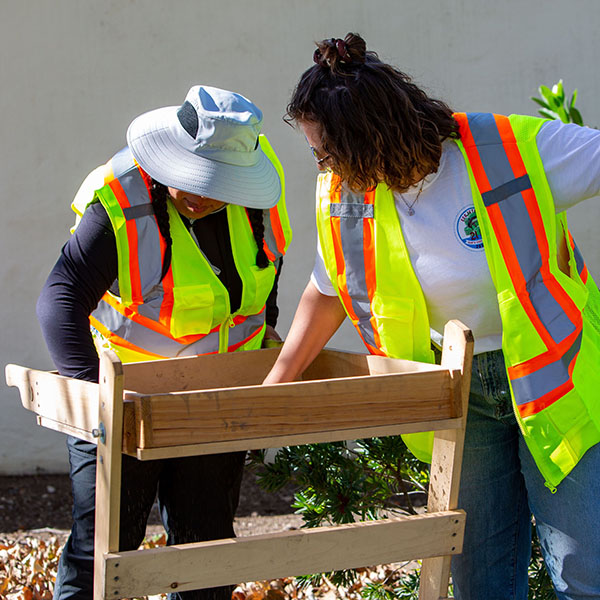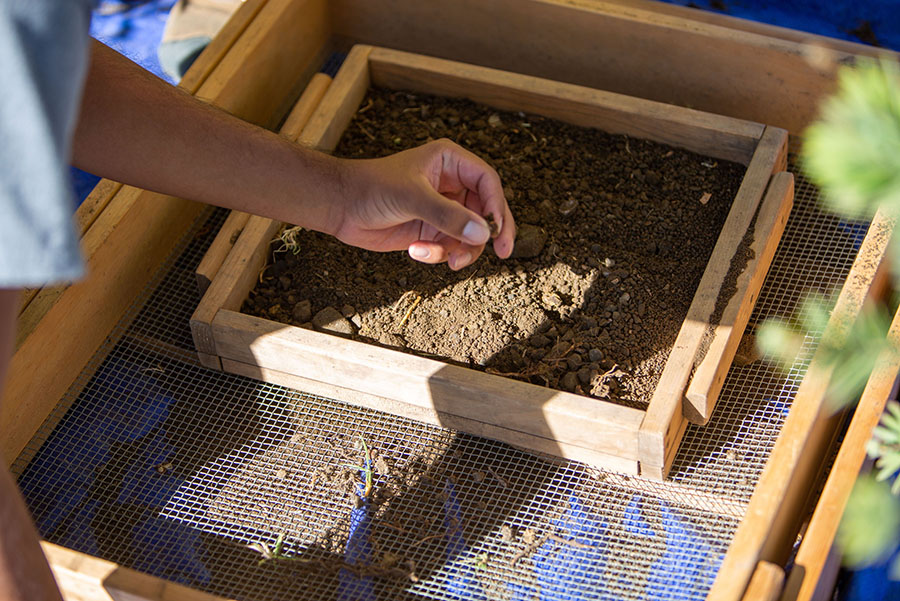by Kim Lamb Gregory
 As the CSUCI workers improve the campus for the future, an archaeology team of undergraduates keeps a watch on the past.
As the CSUCI workers improve the campus for the future, an archaeology team of undergraduates keeps a watch on the past.
Every time a spade hits the dirt on some construction or other manmade modification on campus, a team supervised by Professor of Anthropology Colleen Delaney, Ph.D., waits nearby making sure buried historic artifacts or other remnants of our regional history are protected.
“We’ve found shells, some beads, buttons from some of the Camarillo Hospital patients, old medicine bottles—lots of colored glass,” said Class of 2024 Anthropology major Daniela Valenzuela, a member of the team. “When we find something, we take it back to the lab where it has to be catalogued, measured, weighed and placed in a bag with a note about where and how it was found.”
Currently including six students, the Cultural Resource Management Team was formed in 2021, when Delaney realized construction was going on around the campus that might impact buried cultural heritage. State and federal laws mandate that cultural resources on campuses be protected so Delaney put together a team of undergraduate Anthropology students with an interest in archaeology.
“I took the opportunity to hit two birds with one stone,” Delaney said. “We are keeping the campus in compliance with the law, and at the same time training the students to do archaeology work.”
Delaney said this team could well be one of the only if not the only undergraduate archaeology team in California if not the nation, doing this type of work on campus. Armed with trowels, brushes, screens, measuring tapes, storage bags and pens, the students take samples from the construction site, sift through the dirt, and debris, and look for artifacts.
“We’ve been focusing on transecting and surveying,” said Anthropology/Psychology major Karissa Smathers. “I’ve found shells—they are really hard, so they survive—and some leftover kitchen refuse. I’ve found fish vertebrae, shark vertebrae, and other items that show us what those in the past were eating.”
 The ground under CSU Channel Islands likely has layer upon layer of artifacts that date back thousands of years to when the Chumash and their ancestors dwelled here, next to Sat’wiwa (Round Mountain). Sat’wiwa was considered a sacred site by the local mitsqanaqan̓ (Ventureño) Chumash.
The ground under CSU Channel Islands likely has layer upon layer of artifacts that date back thousands of years to when the Chumash and their ancestors dwelled here, next to Sat’wiwa (Round Mountain). Sat’wiwa was considered a sacred site by the local mitsqanaqan̓ (Ventureño) Chumash.
The campus was part of Lewis Ranch in the early 1900s, and later, in 1932, Camarillo State Hospital, the largest psychiatric hospital in the state.
“Protecting our cultural heritage is a priority for this University,” Delaney said.
With all of the construction planned for the campus such as Gateway Hall and the new Childcare center, the team has its work cut out for it. In November, the undergraduate archaeologists were testing the area along the west side of Camarillo Street south of Santa Barbara Avenue, where President Richard Yao, Ph.D., has determined as the future location of the Early Childhood Care & Education Center (ECCEC).
The team spent hours transecting the area—which means students use measuring string to create a grid around a certain area—and taking and sifting through samples.
“We focused on sub-surface testing the areas that would be affected by the construction of the new childcare building,” Smathers said. “We had to watch out for the water lines and the sprinkler system!”
The students won’t know if they turned up anything of cultural significance until they get a chance to do more testing in the lab through the end of the semester. Each painstaking sift through the dirt, and each lab test is integral to the larger goal of protecting archaeological resources that can never be replaced, once disturbed.
“Heritage is a part of a community’s past and present identities,” Delaney said. “And by protecting ours, we are allowing future generations to know their heritage, too.”
